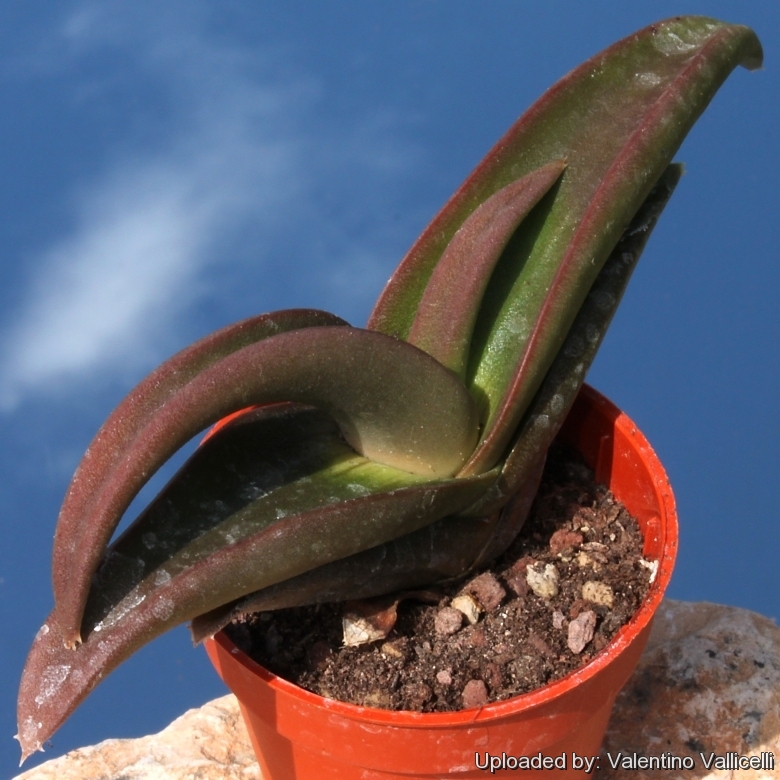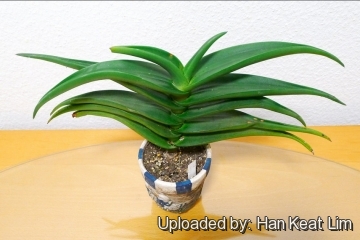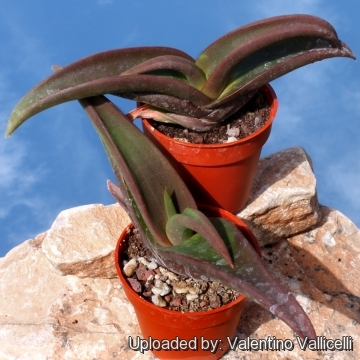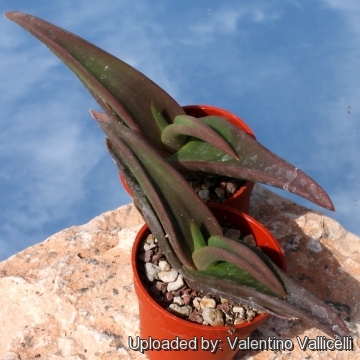




Your support is critical to our success.

Origin and Habitat: Mountains of Yemen, Oman, Saudi Arabia.
Habitat: Grow among rocks often on limestone-capped sandstone massif.
Synonyms:
- Aloe fleurentiniorum Lavranos & L.E.Newton
Description: Aloe fleurentiniorumSN|14428]]SN|14428]] is a nearly black plant with pale to deep pink flowers that flowers much of the year while most other aloes do not. There is a lot of variation in this species.
Habit: Usually acaulescent, sometimes shortly caulescent, simple low to the ground or sometime forming an upright stem and suckering.
Rosette: Open with 8-20 leaves.
Leaves: 60-90 cm long, 15-18 cm wide, lance-shaped, thick, recurved, tapering rough or suede-textured that feel like worn velveteen and slightly ridged, olive green, dark green to nearly black with brownish-purple hue when not under stress, when stressed, the leaves are red-orange. In shadier locations stays a deep green. Margins with small firm teeth 1-1,5 mm long (there is also a toothless form called 'edentata'). Leaf juice yellow turning brownish in air.
Inflorescence: 3-6-branched, 35-40 cm tall. Terminal racemes cylindrical, lax with 10 to 20 flowers;
Flowers: 31-33 mm long constricted at their base, pink to bright red with a hint of yellow at the mouth, ovary about 8 mm in diameter. Subtending bracts pointed 6-8 mm long. Outer tepals 9-10 mm long fused together. Stamens exerted 1 to 2 mm. Style not protruding.
Blooming season: It flowers multiple times a year but mainly in mid to late summer, as well as winter.
Chromosome number: 2n = 14.
Bibliography: Major references and further lectures
1) Urs Eggli, Leonard E. Newton: "Etymological Dictionary of Succulent Plant Names" Springer, Berlin/Heidelberg 2010, ISBN 978-3-642-05597-3,
2) J. J. Lavranos, L. E. Newton: “Two new species of Aloe from Arabia”. In: Cactus and Succulent Journal. Band 49, Nummer 3, Cactus and Succulent Society of America, 1977, S. 113–114.
3) John Jacob Lavranos, Iris Sheila Collenette: “New aloes from Saudi Arabia: part 2.” In: Cactus and Succulent Journal. Band 72, Nummer 2, Cactus and Succulent Society of America, 2000, S. 86–87.
4) Leonard Eric Newton: “Aloe fleurentinorum.” In: Urs Eggli: “Sukkulenten-Lexikon. Einkeimblättrige Pflanzen (Monocotyledonen).” Eugen Ulmer, Stuttgart 2001, ISBN 3-8001-3662-7, S. 138.
5) Urs Eggli “Illustrated Handbook of Suculent Plants: Monocotyledons” Springer, 2001.
6) Susan Carter, John J. Lavranos, Leonard E. Newton, Colin C. Walker “Aloes. The definitive guide.” Kew Publishing, Royal Botanic Gardens, Kew 2011, ISBN 978-1-84246-439-7, S. 251.

Aloe fleurentiniorum Photo by: Han Keat Lim

Aloe fleurentiniorum Photo by: Valentino Vallicelli

Aloe fleurentiniorum Photo by: Valentino Vallicelli
The gallery now contains thousands of pictures, however it is possible to do even more. We are, of course, seeking photos of species not yet shown in the gallery but not only that, we are also looking for better pictures than those already present. Read More...
Cultivation and Propagation: It is is an intersting succulent easy to cultivate under a wide variety of climatic conditions provided it is planted in a well-drained situation given adequate water but not over-watered. Although it originates in most arid regions, in cultivation it can tolerate more water - but when over irrigated or in heavy soils the leaves will split open. It is also a great choice for a hillside garden as roots are very tenacious.
Growth rate: This is a slow grower and in a container, may want to become root bound before it exhibits much growth.
Soil: Well-de-composed compost addition to well draining sandy-gritty mix creating a rich soil is advantageous. It prefers soil of a medium or slightly acidic pH.
Pots: It needs a relatively shallow pot to accommodate its fibrous roots and provide a very good drainage. It may stay in the same pot for many years.
Watering: Water aloes more than other succulents, keeping in mind that the pots dry out between watering. Keep dry in winter or when night temperatures remain below 10° C. Water it less than average if in bigger pots. Outdoors it grows to astonishing proportions also in areas with wet winters, so don't be afraid to plant this in a high-rainfall area. They are really not very demanding and regular watering in their growing season creates healthy disease resistant plants that will flower better.
Special need: Provide very good ventilation. Nearly all problems occur as a result of overwatering and poor ventilation, especially when weather conditions are dull and cool or very humid.
Fertilization: Light fertilizer seems to boost its growth whenever additional water is given. Feed it during the growing season with a fertilizer specifically formulated for cactus and succulents (high potash fertilizer with a dilute low nitrogen), including all micro nutrients and trace elements diluted to ½ the strength recommended on the label. It thrive in poor soils and needs a limited supplies of fertilizer to avoid the plant developing excess vegetation, which is easily attacked by fungal diseases.
Exposure: It will do its best in full sun to light shade and become stressed with inadequate light which could result in poor growth and unnatural shape. Will handle very harsh sunlight, sometimes taking on a coppery leaf sheen, a sign generally associated with stress.
Hardiness: It is a hardy aloe but not completely frost resistant. It will survive light frost but the flowers will not, but for safe cultivation it is best to avoid freezing temperatures. USDA Zone 9b-11 .
Pest and diseases: Occasionally these plants are infested by scale and aphids, but all known garden pests can be kept to a minimum by simply ensuring optimal growing conditions and healthy plants.
Use: It can be cultivated outdoors in raised beds and terraces. It do well in big pots as well.
Maintenance: Removal of old flower stalks.
Propagation: It can be propagated by seed and suckers (if available). Sow seed in a well drained medium in shallow trays and cover lightly with sand or the seed will blow away. Once the seeds begin to germinate, keep moist but watch out for overwatering as the seedlings could rot. Transplant into small pots once they are about 3-4 cm high (approximately 6 months) using a sandy loam medium and feed with organic fertilizer at least once a quarter to ensure healthy growth.
| Your Actions | |
|---|---|
| Back to Aloe index | |
| Back to Aloaceae index | |
 |
Back to Succulents Encyclopedia index |
Privacy stantement - Terms and conditions - How to cite - About us - Feedback - Donate



